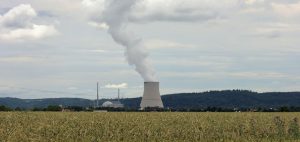Nuclear
Oxford Research

Nuclear fission produced 10.4% of the world’s electrical energy in 2019
Work in Oxford addresses a wide spectrum of nuclear research, from developing the scientific understanding of nuclear materials and processes for fission and fusion energy through to the socio-economic impacts of new nuclear energy systems. The Oxford-Bristol Nuclear Research Centre, now part of the South West Nuclear Hub works closely with the nuclear industry and its stakeholders to identify and address important topics in both fission and fusion. Oxford is also a founding partner in the National Nuclear User Facility (NNUF) at the Culham Centre for Fusion Energy, which is extending the application of our advanced methods for the testing and characterisation of materials for nuclear power generation to active samples.
Nuclear fission
The economic and safe operation of nuclear plant requires an understanding of the ways that materials age in aggressive environments. This is important both for generating the safety cases for life-extension of the current fleet of nuclear power stations, and for designing future materials for Generation IV fission and fusion plants that will place even greater demands on engineering materials. Oxford’s research portfolio, across the departments of materials, engineering, chemistry and computer science, includes work on stress corrosion cracking mechanisms in corrosion resistant alloys in current plant; interactions between residual stress and creep life in stainless steel welds in nuclear systems; the enhancement of zirconium fuel cladding alloys for improved safety and performance; fracture resistance in nuclear graphite and high temperature ceramic composites for high temperature reactors; the development of oxide-dispersion strengthened steel alloys for extreme environments; irradiation-tolerant materials for fusion energy, the chemistry of actinides in nuclear waste, robotic sensory networks to monitor stored nuclear waste and geophysical assessment of storage and new build sites. All of this research is in collaboration with nuclear stakeholders, national laboratories and nuclear industries in the UK and internationally.
Nuclear fusion
Oxford’s physicists work on understanding the behaviour of the large volume of gas, heated to over ten times the temperature at the centre of the sun, that will form the core of a fusion reactor based on ‘magnetic confinement’. The methods and theory of the alternative ‘inertial laser-fusion’ reactor are also addressed, using the tools and concepts of astrophysics. Oxford research also investigates the new and improved materials that are critical for fusion energy: including high temperature superconductors, reduced-activation steels to eliminate long-lived waste, radiation-resistant copper alloys for heat extraction components and plasma-resistant tungsten.
Robotics
Future operation and decommissioning of nuclear power facilities, both fission and fusion, will require the use of robotics to minimise the risk to humans from radiation and other hazards. Researchers from the Oxford Robotics Institute (ORI) have developed a number of autonomous robotics solutions for mapping and monitoring nuclear facilities, including large-scale lidar-based mapping, control algorithms for quadrupeds in unstructured environments, and risk-aware mission planning for deploying autonomy in hazardous settings. This work led to the deployment of a mobile robot for radiation mapping around the JET Hall, and to the use of a Boston Dynamic’s Spot robot for mapping and inspection in a UKAEA facility at Culham and at Sellafield. ORI academics continue to collaborate with UKAEA’s RACE unit on autonomous robotics for long-term site monitoring, and will contribute to the forthcoming Sellafield Centre of Expertise in Robotics and AI.
Nuclear futures
Forming a balanced view on the future of nuclear power requires understanding and information on future technologies and their role in policy and governance. Defining the risks, safety and environmental impact of nuclear energy are critical for public and regulator acceptance of the technology, and the next generation of nuclear power systems must be demonstrably safer, proliferation resistant and efficient. Oxfords’ researchers contribute to national forums including the UK Nuclear Innovation and Research Advisory Board NIRAB, OECD-NEA, European Energy Research Alliance and Gen IV GIF and is a member of the SW Nuclear Hub.
Recent nuclear papers
Recent papers on Nuclear can be found on the Oxford University Research Archive (ORA), a permanent and secure online archive of research materials, including articles, conference papers, theses, research data, working papers and posters produced by members of the University of Oxford. Some recent abstracts produced by Nuclear Researchers:
Deformation localisation in ion-irradiated Fe and Fe10Cr | Department of Materials (ox.ac.uk)
The role of β-Zr in a Zr-2.5Nb alloy during aqueous corrosion: a multi-technique study


